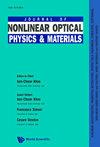From spectral analysis to hysteresis loops: a breakthrough in the optimization of magnetic nanomaterials for bioapplications
IF 2.3
4区 物理与天体物理
Q2 OPTICS
引用次数: 0
Abstract
An innovative method is proposed to determine the most important magnetic properties of bioapplication-oriented magnetic nanomaterials exploiting the connection between hysteresis loop and frequency spectrum of magnetization. Owing to conceptual and practical simplicity, the method may result in a substantial advance in the optimization of magnetic nanomaterials for use in precision medicine. The techniques of frequency analysis of the magnetization currently applied to nanomaterials both in vitro and in vivo usually give a limited, qualitative picture of the effects of the active biological environment, and have to be complemented by direct measurement of the hysteresis loop. We show that the very same techniques can be used to convey all the information needed by present-day biomedical applications without the necessity of doing conventional magnetic measurements in the same experimental conditions. The spectral harmonics obtained analysing the response of a magnetic tracer in frequency, as in magnetic particle spectroscopy/imaging, are demonstrated to lead to a precise reconstruction of the hysteresis loop, whose most important parameters (loop’s area, magnetic remanence and coercive field) are directly obtained through transformation formulas based on simple manipulation of the harmonics amplitudes and phases. The validity of the method is experimentally verified on various magnetic nanomaterials for bioapplications submitted to ac magnetic fields of different amplitude, frequency and waveform. In all cases, the experimental data taken in the frequency domain exactly reproduce the magnetic properties obtained from conventional magnetic measurements.从光谱分析到磁滞回线:生物应用磁性纳米材料优化的突破
提出了一种利用磁滞回线与磁化频谱之间的联系来确定生物应用磁性纳米材料最重要的磁特性的创新方法。由于概念和实践的简单性,该方法可能导致在精确医疗中使用的磁性纳米材料的优化方面取得实质性进展。目前应用于体外和体内纳米材料的磁化频率分析技术通常只能给出活性生物环境影响的有限定性图像,并且必须通过直接测量磁滞回线来补充。我们表明,完全相同的技术可以用来传达当今生物医学应用所需的所有信息,而无需在相同的实验条件下进行传统的磁测量。分析磁示踪剂在频率上的响应所得到的频谱谐波,如在磁粒子光谱/成像中,被证明可以导致磁滞回线的精确重建,其最重要的参数(环路面积、剩磁和矫顽力场)是通过基于简单的谐波幅值和相位的变换公式直接得到的。在不同振幅、频率和波形的交流磁场作用下,实验验证了该方法的有效性。在所有情况下,实验数据采取的频域准确再现从传统的磁性测量得到的磁性。
本文章由计算机程序翻译,如有差异,请以英文原文为准。
求助全文
约1分钟内获得全文
求助全文
来源期刊
CiteScore
3.00
自引率
48.10%
发文量
53
审稿时长
3 months
期刊介绍:
This journal is devoted to the rapidly advancing research and development in the field of nonlinear interactions of light with matter. Topics of interest include, but are not limited to, nonlinear optical materials, metamaterials and plasmonics, nano-photonic structures, stimulated scatterings, harmonic generations, wave mixing, real time holography, guided waves and solitons, bistabilities, instabilities and nonlinear dynamics, and their applications in laser and coherent lightwave amplification, guiding, switching, modulation, communication and information processing. Original papers, comprehensive reviews and rapid communications reporting original theories and observations are sought for in these and related areas. This journal will also publish proceedings of important international meetings and workshops. It is intended for graduate students, scientists and researchers in academic, industrial and government research institutions.

 求助内容:
求助内容: 应助结果提醒方式:
应助结果提醒方式:


